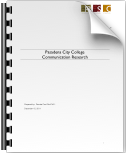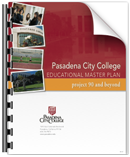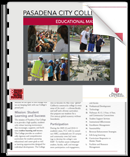GLOSSARY
ACCELERATION:
Acceleration models, most commonly discussed in the context of developmental education, modify traditional course sequences to reduce sequence length, reduce the number of potential exit points, and move more students through sequences more quickly.
A variety of acceleration strategies exist*:
- Avoidance models, which help students “avoid” developmental courses (e.g., intensive math review before taking placement tests, high school articulation programs, summer prep courses)
- Compression models, which combine multiple levels of a sequence in an intensive format within the same semester
- Mainstreaming models, which place developmental students in a transfer-level course with additional support (e.g., SI)
- Modular redesign models, which replace traditional course sequences with individual learning modules
- Curricular redesign models, which shorten the pipeline by providing open access intensive developmental courses leading directly to college-level courses after one semester
* From Hern and Snell’s Spring 2011 3CSN Links presentation, “Bringing Accelerated English and Math to Your Campus”
ASSESSMENT:
Continuous data-informed assessment is used by faculty to improve student learning by regularly examining and evaluating data on teaching and learning practices.
COHORTS:
An entire class or a group of students in a class who
- move together as a group into another class the next semester (and, perhaps, subsequent semesters)
- are enrolled together in more than one class and move together as a group into more than one class the next semester (and, perhaps, subsequent semesters)
Note: XL, Ujima, and Puente are cohort programs with linked classes.
CONTEXTUALIZED INSTRUCTION:
Integration of reading, writing, and math skills into academic subjects or disciplines. Students are engaged with both academic course content and basic skills learning.
CURRICULAR REDESIGN:
Rethink and revamp curriculum in both developmental and college-level courses. Most curricular redesigns involve streamlining course sequences from developmental to college-level classes.
FIRST-YEAR EXPERIENCES:
FYEs focus on the needs of first-year students (college-ready or not).
An FYE
- is a pathway and/or has cohorts (if it extends beyond the fall semester)
- may include learning communities
- integrates instruction with student support services
Note: Ujima and Puente refer to themselves as empowerment programs not FYEs. XL is an SB/FYE.
The PCC First-Year Pathways is an SB/FYE.
LEARNING COMMUNITIES:
According to many educators, classes must have all of the following characteristics to be considered a true LC:
- An LC is an entire class of students who are enrolled in two or more classes in one semester.
- LC instructors
- have developed and integrated their curriculums as a team, often around a common theme
- meet regularly to coordinate lesson plans and assignments, discuss students’ progress, etc.
- quite often appear in each others’ classes
- LC coursework is often project or problem-based.
- Students in an LC may or may not move together the following semester into another LC.
Note: Learning communities may or may not be cohorts, and cohorts may or may not be learning communities.
MODULAR COURSES:
Developmental classes which are broken into smaller, competency based units.
PATHWAYS:
A pathway is a sequence of guaranteed classes that moves students toward successful completion of a specific academic goal (e.g., completion of the basic skills math sequence, the first year of college, 20 units, a CTE certificate, transfer…).
Note: Pathways are not necessarily cohorts. (Students in a pathway can move from one course to another individually or as a group.) Students can start a new pathway after completing one and can be in more than one pathway at one time.
PORTAL:
A portal is essentially an area of a website that centralizes and streamlines all of the online tools, resources, and social media available to students. Components of a portal include, but are not limited to, a “single sign-on” to allow access to financial aid help, information about campus clubs and organizations, course enrollment, degree status check, and so on.
A portal is…
- Customised -
A portal adapts to the user, and the more it knows about the user, the better it should be to adapt to his/her needs, whether the user is an instructor, administrator, student, or prospective student. It should also be able to adapt to the type of hardware that the user is currently using (PC on a dial-up phone, PDA, or smart phone.) This should be done as the user logs into the portal. - Personalized –
A portal allows the user to change the portal’s interface and behavior to meet the user’s needs and preferences. This would include the appearance (colors, fonts, size), channels subscribed to and their location on screen. - Adaptive –
A portal changes its behavior depending on the context. Many people will have multiple roles and will present information or channels depending on activity. It will also have an
SUMMER BRIDGES:
The primary goal of an SB is to help students make a successful transition from high school to college. An SB program typically includes
- an orientation to college
- study skills and time management activities
- course content (e.g., reading or math, credit or no-credit)
- community-building activities
Note: A summer bridge is sometimes linked to a first-year experience program.
STUDENT SUCCESS COURSES:
Student Success Courses: Courses that focus on Students’ study skills and provide an introduction to college life.
SUPPLEMENTAL INSTRUCTION:
A more structured tutoring model where the Supplemental Instructor or SI attends the class and works with students outside the class on problem-based study sessions.
TECHNOLOGY-AIDED INSTRUCTION:
The use of technology to aid instruction: My Mathlab, ALEKS, Lecture Capture, etc.
TUTORING:
This service is provided by faculty, staff, students, or computer-assisted instruction with tutorial software packages.



